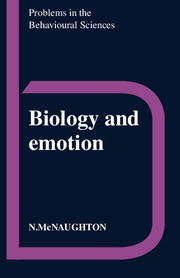Book contents
- Frontmatter
- Contents
- Preface
- Acknowledgements
- 1 Emotion since Darwin
- 2 Releasers and state-dependent reflexes
- 3 Purpose and emotion
- 4 Expression: a window on the emotions?
- 5 Are physiological changes epiphenomena of emotion?
- 6 Somatic influences on the emotions
- 7 Optimal foraging and the partial reinforcement effect: a model for the teleonomy of feelings?
- 8 Do emotions mature or differentiate?
- 9 Cognition, learning and emotion
- 10 Interaction of the components of emotion
- 11 Of mice and men
- 12 Biology and emotion: some conclusions
- Glossary
- Notes
- References
- Index
4 - Expression: a window on the emotions?
Published online by Cambridge University Press: 05 August 2012
- Frontmatter
- Contents
- Preface
- Acknowledgements
- 1 Emotion since Darwin
- 2 Releasers and state-dependent reflexes
- 3 Purpose and emotion
- 4 Expression: a window on the emotions?
- 5 Are physiological changes epiphenomena of emotion?
- 6 Somatic influences on the emotions
- 7 Optimal foraging and the partial reinforcement effect: a model for the teleonomy of feelings?
- 8 Do emotions mature or differentiate?
- 9 Cognition, learning and emotion
- 10 Interaction of the components of emotion
- 11 Of mice and men
- 12 Biology and emotion: some conclusions
- Glossary
- Notes
- References
- Index
Summary
Your face, my thane, is as a book where men
May read strange matters. To beguile the time,
Look like the time; bear welcome in your eye,
Your hand, your tongue: look like the innocent flower,
But be the serpent under't.
William Shakespeare: MacbethWhy do emotions produce expressions?
Common experience suggests that emotional states are reflected in facial and bodily expressions, and that in some cases specific states may result in specific, identifiable, expressions. It would be parsimonious if we could assume that an emotion releases a facial expression (Chapter 2). However, unlike organised skeletal responses or internal physiological change, facial expression has neither a direct physical effect on the external environment nor any obvious function with respect to the internal environment. The main function of expressions can be presumed to be communication (see Chevalier-Skolnikoff, 1973, p.20). Particularly with human beings, therefore, it is possible that expressions would be deliberate rather than reflexive and that the form of an expression could be easily learned rather than being innate (cf. the different gestures used in the various sign languages). How closely particular expressions are linked to particular emotions, the extent to which they are learned, and the extent to which they do in fact convey information, are all important questions.
- Type
- Chapter
- Information
- Biology and Emotion , pp. 40 - 50Publisher: Cambridge University PressPrint publication year: 1989
- 1
- Cited by

